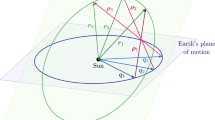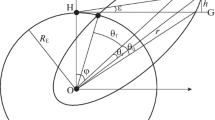Abstract
Earlier work on the angles and angular rate initial orbit determination problem has been extended to allow the incorporation of arbitrary amounts and mixtures of angles and angular rate data. The statistical estimation technique used is that of Maximum Likelihood. Numerical tests on six widely different satellite orbits indicate that the orbital elements can generally be computed to 1% from data acquired during a single apparition.
Similar content being viewed by others
References
Kendall, M. G. and Stuart, A.: 1973,The Advanced Theory of Statistics, Vol. 2, Hafner Publishing Co., New York.
Saaty, T. L. and Bram, J.: 1964,Nonlinear Mathematics, McGraw-Hill Book Co., New York.
Taff, L. G. and Hall, D. L.: 1977, Celes. Mech.16, 481.
Author information
Authors and Affiliations
Additional information
This work was sponsored by the Department of the Air Force.
Rights and permissions
About this article
Cite this article
Taff, L.G., Hall, D.L. The use of angles and angular rates. Celestial Mechanics 21, 281–290 (1980). https://doi.org/10.1007/BF01230226
Received:
Accepted:
Issue Date:
DOI: https://doi.org/10.1007/BF01230226




